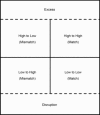The biology of developmental plasticity and the Predictive Adaptive Response hypothesis
- PMID: 24882817
- PMCID: PMC4048093
- DOI: 10.1113/jphysiol.2014.271460
The biology of developmental plasticity and the Predictive Adaptive Response hypothesis
Abstract
Many forms of developmental plasticity have been observed and these are usually beneficial to the organism. The Predictive Adaptive Response (PAR) hypothesis refers to a form of developmental plasticity in which cues received in early life influence the development of a phenotype that is normally adapted to the environmental conditions of later life. When the predicted and actual environments differ, the mismatch between the individual's phenotype and the conditions in which it finds itself can have adverse consequences for Darwinian fitness and, later, for health. Numerous examples exist of the long-term effects of cues indicating a threatening environment affecting the subsequent phenotype of the individual organism. Other examples consist of the long-term effects of variations in environment within a normal range, particularly in the individual's nutritional environment. In mammals the cues to developing offspring are often provided by the mother's plane of nutrition, her body composition or stress levels. This hypothetical effect in humans is thought to be important by some scientists and controversial by others. In resolving the conflict, distinctions should be drawn between PARs induced by normative variations in the developmental environment and the ill effects on development of extremes in environment such as a very poor or very rich nutritional environment. Tests to distinguish between different developmental processes impacting on adult characteristics are proposed. Many of the mechanisms underlying developmental plasticity involve molecular epigenetic processes, and their elucidation in the context of PARs and more widely has implications for the revision of classical evolutionary theory.
© 2014 The Authors. The Journal of Physiology © 2014 The Physiological Society.
Figures



Similar articles
-
The thrifty phenotype as an adaptive maternal effect.Biol Rev Camb Philos Soc. 2007 Feb;82(1):143-72. doi: 10.1111/j.1469-185X.2006.00007.x. Biol Rev Camb Philos Soc. 2007. PMID: 17313527 Review.
-
Evolutionary and developmental mismatches are consequences of adaptive developmental plasticity in humans and have implications for later disease risk.Philos Trans R Soc Lond B Biol Sci. 2019 Apr 15;374(1770):20180109. doi: 10.1098/rstb.2018.0109. Philos Trans R Soc Lond B Biol Sci. 2019. PMID: 30966891 Free PMC article. Review.
-
Epigenetics and the maintenance of developmental plasticity: extending the signalling theory framework.Biol Rev Camb Philos Soc. 2018 Aug;93(3):1323-1338. doi: 10.1111/brv.12396. Epub 2018 Jan 21. Biol Rev Camb Philos Soc. 2018. PMID: 29356358 Review.
-
Environmental influences during development and their later consequences for health and disease: implications for the interpretation of empirical studies.Proc Biol Sci. 2005 Apr 7;272(1564):671-7. doi: 10.1098/rspb.2004.3001. Proc Biol Sci. 2005. PMID: 15870029 Free PMC article. Review.
-
The evolution of predictive adaptive responses in human life history.Proc Biol Sci. 2013 Sep 7;280(1766):20131343. doi: 10.1098/rspb.2013.1343. Print 2013 Sep 7. Proc Biol Sci. 2013. PMID: 23843395 Free PMC article.
Cited by
-
Maternal nutrition and its intergenerational links to non-communicable disease metabolic risk factors: a systematic review and narrative synthesis.J Health Popul Nutr. 2021 Apr 26;40(1):20. doi: 10.1186/s41043-021-00241-2. J Health Popul Nutr. 2021. PMID: 33902746 Free PMC article.
-
IVF, from the past to the future: the inheritance of the Capri Workshop Group.Hum Reprod Open. 2020 Sep 22;2020(3):hoaa040. doi: 10.1093/hropen/hoaa040. eCollection 2020. Hum Reprod Open. 2020. PMID: 33005753 Free PMC article.
-
Cognition, Information Fields and Hologenomic Entanglement: Evolution in Light and Shadow.Biology (Basel). 2016 May 21;5(2):21. doi: 10.3390/biology5020021. Biology (Basel). 2016. PMID: 27213462 Free PMC article.
-
Epigenetics of prenatal stress in humans: the current research landscape.Clin Epigenetics. 2024 Feb 2;16(1):20. doi: 10.1186/s13148-024-01635-9. Clin Epigenetics. 2024. PMID: 38308342 Free PMC article. Review.
-
Sexual stature difference fluctuations in pre- and post-Black Death London as an indicator of living standards.Am J Hum Biol. 2022 Oct;34(10):e23783. doi: 10.1002/ajhb.23783. Epub 2022 Jul 19. Am J Hum Biol. 2022. PMID: 35851510 Free PMC article.
References
Publication types
MeSH terms
Grants and funding
LinkOut - more resources
Full Text Sources
Other Literature Sources
Miscellaneous

